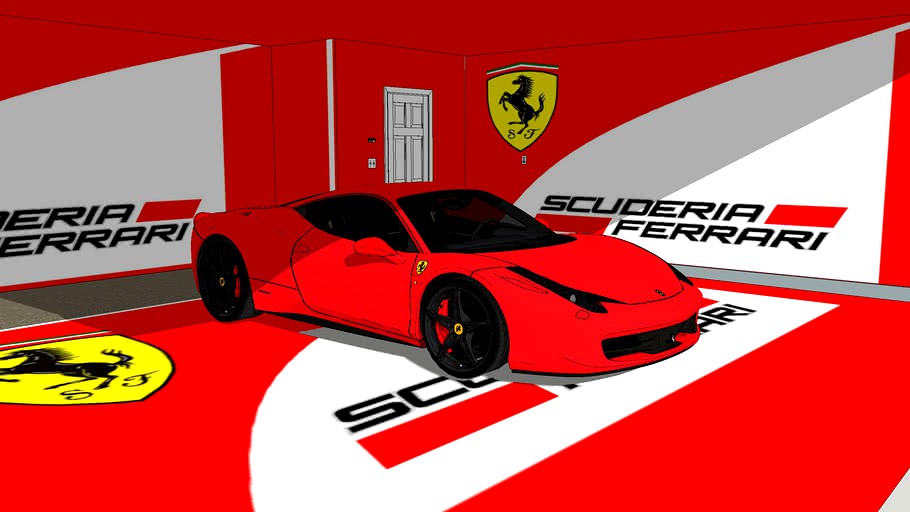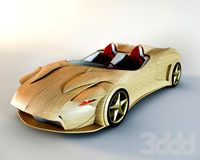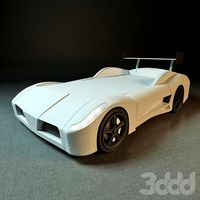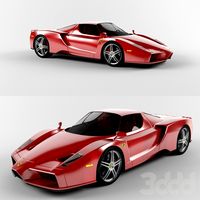3DWarehouse

Ferrari 458 Italia
by 3DWarehouse
Last crawled date: 1 year, 9 months ago
Specifications In Ferrari's first official announcement of the car, the 458 was described as the successor to the F430 but arising from an entirely new design, incorporating technologies developed from the company's experience in Formula 1. The body computer system was developed by Magneti Marelli Automotive Lighting. Engine The 458 is powered by a 4,499 cc (274.5 cu in) V8 engine of the 'Ferrari/Maserati' F136 engine family, producing 570 PS (419 kW; 562 hp) at 9,000 rpm (redline) and 540 N·m (398 lb·ft) at 6,000 rpm7] with 80% torque available at 3,250 rpm. The engine features direct fuel injection, which is a first for Ferrari mid-engine setups in its road cars. Transmission The only transmission available on the 458 is a dual-clutch 7-speed GETRAG gearbox, in a different state of tune shared with the Mercedes-Benz SLS AMG.6] There is no traditional manual option, making this the fourth road-car after the Enzo, Challenge Stradale and 430 Scuderia not to be offered with Ferrari's classic gated manual. It is the first mainstream model to not be offered with a manual transmission. Handling Rear The car's suspension features double wishbones at the front and a multi-link setup at the rear, coupled with E-Diff and F1-Trac traction control systems, designed to improve the car's cornering and longitudinal acceleration by 32% when compared with its predecessors. The brakes include a prefill function whereby the pistons in the calipers move the pads into contact with the discs on lift off to minimize delay in the brakes being applied. This combined with the ABS and standard Carbon Ceramic brakes have caused a reduction in stopping distance from 100–0 km/h (62-0 mph) to 32.5 metres (107 ft). Tests have shown the car will stop from 100 km/h (62.1 mph) in 90 feet (27 m) or in 85 feet (26 m) with run flat tires, 85 feet (26 m) from 60 mph (97 km/h) and 80 feet (24 m) from 60 mph (97 km/h) with run flat tires. The adaptive magnetorheological dampers are co-developed with BWI Group. Performance Ferrari's official 0–100 km/h (62 mph) acceleration is 2.9–3.0 seconds.10] The top speed is 340 km/h (210 mph).11] It has fuel consumption in combined cycle (ECE+EUDC) of 13.3 L/100 km (21.2 mpg-imp; 17.7 mpg-US) while producing 307 g/km of CO2. Design The small aeroelastic winglets generate downforce and, as speed rises, deform to reduce the section of the radiator intake and cut drag. In keeping with Ferrari tradition the body was designed by Pininfarina. The car’s exterior styling and features were designed for aerodynamic efficiency, producing a downforce of 140 kg (309 lb) at 200 kilometres per hour (120 mph).In particular, the front grille features deformable winglets that lower at high speeds, in order to offer reduced drag. The car's interior was designed using input from former Ferrari Formula 1 driver Michael Schumacher; in a layout common to racing cars, the new steering wheel incorporates many controls normally located on the dashboard or on stalks, such as turning signals or high beams. According to British car magazine Autocar, the 458 Italia's design has drawn inspiration from the Enzo Ferrari and its Millechili concept car. It has been designed to be Ferrari's sportiest V8-engined car, to distinguish itself from the recently launched Ferrari California. The 458 was also reviewed on the 15th season of Top Gear, where it received acclaim for its styling and performance. In a drag race against James May's Ferrari F430, it won by a considerable margin. The car also lapped the Top Gear test track in 1:19.1, just 0.1 seconds slower than the Ferrari Enzo.
Similar models
3dwarehouse
free

Ferrari 458 Italia Spider
...n by a considerable margin. the car also lapped the top gear test track in 1:19.1, just 0.1 seconds slower than the ferrari enzo.
cg_trader
$39

Ferrari 458 Italia High Poly Realistic 3D Model
...lassic racing rim enzo audi lamborghini luxury car racing car sport car car rim car tire car wheel classic car race car sport car
3dwarehouse
free

2010 Hyundai Veloster
...37 mpg‑imp) combined.5] for some markets like the middle east, chile and brazil, the car is offered without gdi, making 128 hp.6]
3d_ocean
$89

Ferrari 458 Italia
...ian sports car manufacturer ferrari. the 458 replaced the ferrari f430, and was first officially unveiled at the 2009 frankfur...
grabcad
free

FERRARI F430
...the ferrari 360, it debuted at the 2004 paris motor show. it was succeeded by the ferrari 458 which was unveiled on 28 july 2009.
3dwarehouse
free

McLaren MP4-12C 2011
...2 kph power to weight: 461 ps (455 bhp) per tonne co2: 279 g/km fuel consumption (combined): 11.7 l/100 km / 24.2 mpg (uk) #tayel
3dwarehouse
free

Ferrari F12berlinetta
...– and produces co2 emissions of 350 g/km. transmission similar to the california, 458 italia, ff and laferrari, the...
grabcad
free

Koenigsegg Agera
... with a gps-verified two-way average top speed of 277.9 mph (447 km/h) and a fastest straight-line speed of 284.55 mph (458 km/h)
3dwarehouse
free

VW W12 Nardo
...ill to 100 km/h (62 mph) in about 3.5 seconds, and had a top speed of 357 km/h (221.8 mph). #syncro #phaeton #continental #veyron
3dwarehouse
free

Hyundai Azera / Grandeur 2006
...e #azera #car #coche #coréen #engine #grandeur #grey #gris #highway #hyundai #joce #korean #luxury #model #sedan #sonata #voiture
458
3d_export
$5

ferrari 458 italia
...ferrari 458 italia
3dexport
ferrari 458 italia
3d_ocean
$89

Ferrari 458 Italia
...ian sports car manufacturer ferrari. the 458 replaced the ferrari f430, and was first officially unveiled at the 2009 frankfur...
3d_ocean
$50

Ferrari 458 Italia
...458 italia
3docean
3d model download ferrari italia
high fidelity – ferrari 458 italia 3d model low poly obj format with textures
3d_export
$99

458 Italia 3D Model
...aranello fiat f1 speed realistic interior wheel tyre rim engine italy italian supercar
458 italia 3d model fabelar 43766 3dexport
3d_export
$29

Ferrari 458 Italia 3D Model
... 3d model
3dexport
ferrari italia italy 458 supercar sport fast 2010 2011 2012
ferrari 458 italia 3d model pachhe7 71529 3dexport
cg_studio
$109

Ferrari 458 Italia3d model
...458 italia3d model
cgstudio
.max - ferrari 458 italia 3d model, royalty free license available, instant download after purchase.
3d_export
$89

Ferrari 458 Italia 2011 3D Model
...ferrari 458 italia 2011 3d model
3dexport
ferrari 458 italia 2011
ferrari 458 italia 2011 3d model stm39 18995 3dexport
3d_export
$99

Ferrari 458 Speciale 2014 3D Model
...ian fast italy supercar special ferrari f458 458 f-458 speciale specialle
ferrari 458 speciale 2014 3d model squir 76093 3dexport
3d_export
$99

Ferrari 458 Italia 3D Model
...rrari 458 f458 italia italy italian 2009 2010 2011 2012 2013 sport fast supercar
ferrari 458 italia 3d model squir 18783 3dexport
cg_studio
$99

Ferrari 458 Italia3d model
...gstudio
.3ds .lwo .max .obj .xsi - ferrari 458 italia 3d model, royalty free license available, instant download after purchase.
Ferrari
3ddd
free

Ferrari
... milleno , sport , car
ferrari milleno
3ddd
$1

Ferrari
...ferrari
3ddd
ferrafi , автомобиль
ferrari
3ddd
$1

Кровать Ferrari
...кровать ferrari
3ddd
ferrari
детская кровать ferrari.
3ddd
$1

pen ferrari
...pen ferrari
3ddd
pen ferrari , ручка
pen ferrari
3ddd
$1

Ferrari Enzo
...ferrari enzo
3ddd
ferrari
высокополигональная модель ferrari enzo
3ddd
$1

Ferrari cup
...rrari , кружка , чашка
3d модель кружки ferrari
3ddd
$1

Ferrari wheel
...ferrari wheel
3ddd
ferrari , колесо
высокополигональная модель колеса от ferrari.
3d_ocean
$39

Ferrari F150
...ferrari f150
3docean
car f1 ferrari motor
f1 ferrari f150 with pilot.
3d_export
$20

ferrari f40
...ferrari f40
3dexport
ferrari f40
3d_export
$20

ferrari california
...ferrari california
3dexport
ferrari california
Italia
3ddd
$1

CL Italia
...cl italia
3ddd
cl italia , sofa
cl italia
3ddd
free

Saba Italia
...dd
saba italia , settanta , угловой
saba italia
3ddd
free

Cattelan Italia
...cattelan italia
3ddd
cattelan italia
cattelain italia, кресло, диван
3ddd
$1

сattelan italia
...сattelan italia
3ddd
комод , сattelan italia
сattelan italia, размеры 600x1480x730h
3ddd
$1

Cattelan Italia
...cattelan italia
3ddd
cattelan italia
стол и стул фирмы cattelan italia
3ddd
$1

Cattelan Italia
...telan italia
3ddd
cattelan italia , комод
cattelan italia комод
размеры: 2000х500х780(н)
3ddd
$1

Ditre Italia
...ditre italia
3ddd
ditre italia
современный диван-софа
3ddd
free

Casa Italia
... витрина
стандартный набор фасадов и элементов из линейки типоразмеров casa italia (аналог фасадов rialto).
3ddd
$1

Terra Italia / Emozioni
...terra italia / emozioni
3ddd
terra italia , шкаф
terra italia
3ddd
free

Stol Cattelone italia
...stol cattelone italia
3ddd
cattelan italia
cattelone italia teable
